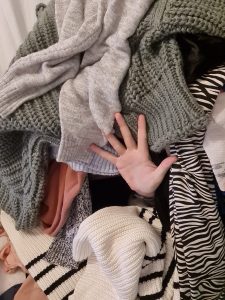This case study Q&A with DMU’s Sally Gaukrodger-Cowan explores an innovative approach to exploring Responsible Fashion with students…
The project is called T-Extinction – what is it about, who helped to develop it and who can take part?
The project was set up originally by Senior Lecturer Sally Gaukrodger-Cowan and Professor Carolyn Hardaker after a discussion about what was happening in the world in the Summer of 2019. As a result of this conversation T-Extinction concept was born. Sally and Carolyn developed a T-Extinction identity with a third year graphics student [frontrunner] Giannis Evangelou. We set a student competition with a chance to work and co-create with Academics from different fashion and textile disciplines. The question on the brief was ‘What item or processes in the fashion and textiles industry are not sustainable? What will be extinct or taboo in the year 2090?’
The project was briefed to all Fashion Buying students. The entries were all first year students. The final exhibition included three academics and seven students from Fashion Buying.
What are students learning and producing by taking part?
The learning is twofold:
- All of the team developed a greater understanding of the UN SDGs and a passion for sustainability. The students had to portray their concept visually with an overview and these ideas were blown up onto huge posters to create thought provoking imagery.
- Students and staff have the opportunity to co-create with peers and lecturers. Students are developing team working skills, independent thought, confidence, organisational skills to meet deadlines and researching skills.
How does the project address some of the main sustainable development challenges in Fashion and Textiles?
The project raised awareness of the changes that had taken place over the past years in Fashion and textiles and encouraged dialogue and enquiry about the future and the safeguarding of our planet. Taking a ‘longtime’ approach (2090), provided a different, thought provoking approach. By the year 2090, our students will be in the elder years and will have had an opportunity to make an impact through their careers.
How does T-Extinction link to learning activities within the taught curriculum in the school?
T-Extinction students who took part were in the first year when it launched and this really heightened their awareness of the importance of sustainability and the UN SDGs. T-Extinction was exciting and added to the buzz of their first term at University.
T-Extinction was originally an extra curricula competition and co-creation. Developing this project helped students to have a deeper understanding of sustainability and it’s impact on Fashion and textiles. The project encouraged a partnership with staff and students. Sally noted that the students she taught demonstrated a much more in depth understanding of sustainability within their learning activities.
What are your future plans for the project?
This is a long term project which can be handed over to different disciplines who can respond in their own unique way. It is hoped Textiles will take it on next year.
Copies of the posters and imagery will be forwarded to the DMU archive and we hope that the students who took part may revisit one day in the future and see if they were right!



Leave a Reply